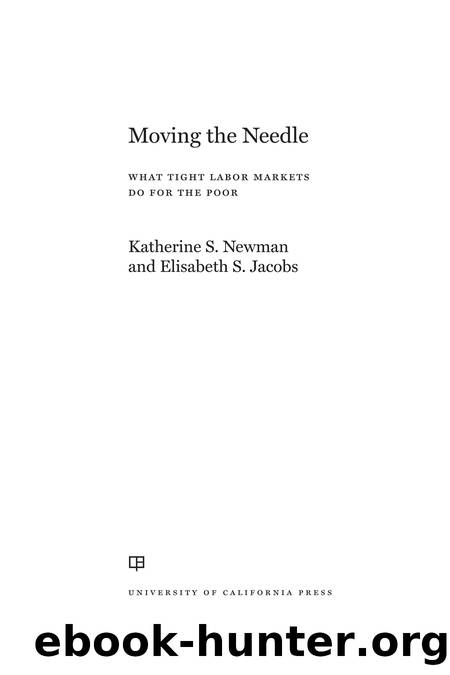Moving the Needle by Katherine S. Newman

Author:Katherine S. Newman
Language: eng
Format: epub
ISBN: 9780520379107
Publisher: University of California Press
THE NEW FATHERHOOD
Marriage is not part of the social equation for many households in Roxbury Crossing and Franklin. But fatherhood is, as it is all over the United States. Nationwide, the share of fathers who stay home full-time with children under age eighteen increased from 4 percent in 1989 to 7 percent in 2016, and fathers made up 17 percent of all stay-at-home parents in 2016 compared with 10 percent in 1989.44 Nearly a quarter of stay-at-home fathers in 2016 reported that they were at home specifically to take care of children full-time, up from just 4 percent in 1989.45 Fathers are now just as likely as mothers to say that parenting is extremely important to their identity, andâperhaps surprisinglyâdads are more likely than moms to report that parenting is both rewarding and enjoyable.46
The disadvantages that accrue to children who grow up living with a single parent (typically mothers) stem from both economic deprivation and from the stress associated with the experience of family disruption.47 When jobs are more plentiful, however, these pressures are moderatedâ in part because noncustodial parents (typically fathers) are better able to provide financial support to their children when their wages increase.
Child support payments serve as one key indicator of noncustodial parentsâ ability to contribute economically to their childrenâs households.48 When a parent lives with a child, they automatically share their income with that child. But when children live apart from a parent, that noncustodial parentâs financial obligations to the child become less clear. Court-ordered child support is designed to serve as a key mechanism for protecting children against the financial consequences of growing up in a single-parent household.49
When we conduct a simple analysis comparing the ratio of child support paid to child support owed, we find the expected inverse relationship with tight labor marketsâbut only when labor markets are very tight. Child support paid as a share of child support owed increases when the unemployment rates is at or below 5 percent, but it does not reach levels of statistical significance until unemployment rates are at or below 4 percent. In very tight labor markets, defined as those where unemployment rates are at or below 4 percent, noncustodial parents are better able to fulfill their child support obligations.50
Specifically, when unemployment rates are at or below 4 percent, households with children receive 16.5 percent more of the child support that theyâre owed. To illustrate this effect, take 2018âthe most recent year for which we have data. The average child support payment was $5,518.76, and the average family received about 86 percent of the amount they were owed. But âaverageâ can obscure important differences, and our analysis shows substantial variation between areas with tight labor markets (unemployment at or below 4 percent) and areas with labor market that were not so tight. In tight labor markets, families received an average of 94 percent of the child support they were owed. In areas where unemployment rates were above 4 percent, the amount received as was 82.5 percent. That support gap adds up to a 12 percentage point difference correlated with very tight labor markets.
Download
This site does not store any files on its server. We only index and link to content provided by other sites. Please contact the content providers to delete copyright contents if any and email us, we'll remove relevant links or contents immediately.
International Integration of the Brazilian Economy by Elias C. Grivoyannis(90511)
The Radium Girls by Kate Moore(11921)
Turbulence by E. J. Noyes(7934)
Nudge - Improving Decisions about Health, Wealth, and Happiness by Thaler Sunstein(7611)
The Black Swan by Nassim Nicholas Taleb(7009)
Rich Dad Poor Dad by Robert T. Kiyosaki(6397)
Pioneering Portfolio Management by David F. Swensen(6226)
Man-made Catastrophes and Risk Information Concealment by Dmitry Chernov & Didier Sornette(5920)
Zero to One by Peter Thiel(5684)
Secrecy World by Jake Bernstein(4639)
Millionaire: The Philanderer, Gambler, and Duelist Who Invented Modern Finance by Janet Gleeson(4373)
The Age of Surveillance Capitalism by Shoshana Zuboff(4206)
Skin in the Game by Nassim Nicholas Taleb(4161)
Bullshit Jobs by David Graeber(4092)
The Money Culture by Michael Lewis(4072)
Skin in the Game: Hidden Asymmetries in Daily Life by Nassim Nicholas Taleb(3929)
The Dhandho Investor by Mohnish Pabrai(3698)
The Wisdom of Finance by Mihir Desai(3648)
Blockchain Basics by Daniel Drescher(3493)
